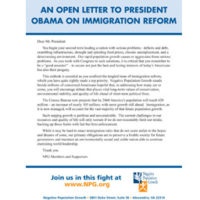Little Known Presidential Population Leadership
- Otis L. Graham, Jr
- January 19, 2013
- Forum Papers
- Forum Paper
- 0 Comments
Clinton agreed to launch the Council, effectively getting in line (whether he knew it or not) to be president #7. Or not, depending upon whether he and the group extended the line of argument begun with Eisenhower, or whether Sustainability to them might take a different direction. The emergence of a vigorous “anti-Malthusian” school in the 1980s and 1990s opened the possibility that Clinton’s PCSD might steer another way. Because Sustainability was a hot and rising idea and slogan, internationally and in the U.S., and seemed to have no enemies and few critics, Clinton convened his Council, Task Forces were formed, meetings were held, several Task Force reports were published (my university library turned up five) and one assumes that advice was given to the president at some time(s) during the six years. Interim reports from some Task Forces were requested in 1996.
The signs of ideological infighting are evident from the start. Someone noticed, it is not clear when, that among the Task Forces on topics such as Education, Global Warming and Conservation of Nature the topic of “population” had been left out. A Task Force on Population and Consumption was belatedly formed, and started work one year after all the others. But it worked vigorously, and when an interim report listing Goals and Policies was requested of all TFs in 1996, the Population/ Consumption group was unflinching. “The size of our population and the scale of our consumption are essential determinants of whether the U.S. will be able to achieve sustainability,” read the Executive Summary at the top. “Therefore the two most important steps the U.S. must take are 1) to stabilize U.S. population promptly and 2) to move toward greater material and energy efficiency in all production and use of goods and services…. A great deal of work needs to be done… as America’s population now grows by three million each year – the equivalent of another Connecticut each year, or a California each decade.” For its future, the U.S. must… stabilize population” so that our society “is sustainable.” Goal #1 of the U.S. should be the “stabilization of (our) population as early as possible in the next century.” Since “One-third of U.S. population growth comes from legal and illegal immigration, now at an all-time high… reducing immigration levels is a necessary part of population stabilization and the drive toward sustainability.” We recommend “policies that reduce illegal immigration.” Legal immigration was “a sensitive issue” requiring more “research.”
“Must stabilize population.” That was a mostly sure-footed, quotable and promising beginning by the almost-unborn Population Task Force. Then something happened on the way from the interim report of 1996 to the PCSD final report of 1999. Toward a Sustainable America was presented at a “National Town Meeting” held in Detroit May 2-5, 1999. The final report presented ten goals, from “a healthy environment” through “Stewardship” and “Education,” with #8 being simply “Population.” That was a peculiar goal, followed by the seven words, “Move toward stabilization of U.S. population.” That was it. Stabilization – but with no entity to do the moving, no timetable. The word stabilization had been uttered once and as a vague direction, in the report of the Council as a whole. In a section labeled “We Believe” came: “We believe some things must grow – jobs, productivity, wages… and some must not… waste, poverty, pollution….” And population? Not listed as must or must not grow. The reader could put it where she wished. The Council as a whole passed up a chance to say.
Graham was Professor Emeritus of history at the University of California, Santa Barbara. He was the author or editor of more than fifteen books, including “Debating American Immigration, 1882-Present” (with Roger Daniels) and “Environment Politics and Policy, 1960s to 1990s”.

